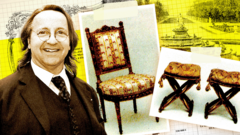In a shocking twist of fate, the Palace of Versailles recently found itself at the center of a major fraud scandal involving fraudulent furniture pieces purportedly belonging to Marie Antoinette. The elaborate scheme, which first surfaced in the early 2010s, began with the sale of two ornate chairs claimed to have historic ties to the last queen of France. These chairs, crafted by celebrated carpenter Nicolas-Quinibert Foliot, were appraised as national treasures by the French government in 2013, setting off a chain of events that would leave the French antiques world in disarray.
Initially showing interest in acquiring the chairs for its museum collection, Versailles soon withdrew when the asking price of €2 million (£1.67m) was deemed excessive. The chairs subsequently found a new home with Qatari Prince Mohammed bin Hamad Al Thani, marking a notable transaction in the luxurious antiques market. In a perplexing turn, additional 18th-century royal furniture items, such as chairs once belonging to King Louis XVI's family, flooded the market, captivating collectors, including Versailles itself. As public demand surged, it became apparent that a significant deception was underway.
By 2016, alarms were raised, revealing that the celebrated chairs – once hailed as gems of French heritage – were actually forgeries. After a thorough investigation spanning nine years, leading antiques expert Georges "Bill" Pallot and fellow cabinetmaker Bruno Desnoues were put on trial. Both men confessed to their fraudulent actions, while Laurent Kraemer, director of Galerie Kraemer, also faced accusations of gross negligence in the sale of the counterfeit items.
The scheme reportedly originated as a playful challenge in 2007 when Pallot and Desnoues sought to replicate an armchair. Their experiment bore fruitful deceit, and they soon produced additional forgeries that they sold through various galleries. With their expertise in wood sourcing, gilding, and designs, the duo navigated the counterfeit industry until their downfall was precipitated by a subsequent investigation into a middleman’s suspicious lifestyle.
During trial proceedings, lawyers for Versailles pointed to Pallot’s access to crucial documentation as a contributing factor to the deception, showcasing how fraud infiltrated well-respected institutions. Prosecutors emphasized a considerable need for more stringent regulations within the art market, drawing attention to the responsibilities of art dealers to conduct thorough checks on the authenticity of items.
The case against Kraemer and his gallery is particularly contentious; while they initially claimed victimhood, prosecutors pushed back by asserting gross negligence in authenticity checks related to their sales of the forged chairs. As the court case draws further attention, there are heightened discussions surrounding the art market's ethical standards and verification protocols.
With the wheels of justice in motion, the ultimate verdict stands as a reminder of the delicate interplay between wealth, art, and trust, as the story unfolds amid one of history's most celebrated cultural institutions.


















